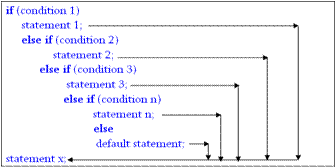- When we have multiple options available or we need to take multiple decisions based on available condition, we can use another form of if statement called else…if ladder.
- In else…if ladder each else is associated with another if statement.
- Evaluation of condition starts from top to down.
- If condition becomes true then the associated block with if statement is executed and rest of conditions are skipped.
- If the condition becomes false then it will check for next condition in a sequential manner.
- It repeats until all conditions are cheeked or a true condition is found.
- If all condition available in else…if ladder evaluated to false then default else block will be executed.
- It has the following syntax:
Syntax:
if (condition 1)
{
// block 1
}
else if (codition 2)
{
// block 2
}
else if(codition 3)
{
// block 3
}
else
{
// default block
}- else…if ladder provides multi way decision making when any one alternative is to be select among the available option.
- The following block demonstrates the use of else if ladder.
#include<stdio.h>
#include<conio.h>
void main()
{
int x, y, z, ch;
clrscr();
printf("\n1.Addition\n2.Subtraction\n3.Multiplication\4.Division\n");
printf("\nEnter your choice :");
scanf("%d", &ch);
printf("\nEnter X and Y :");
scanf("%d %d", &x, &y);
if (ch == 1)
{
z = x + y;
}
else if (ch == 2)
{
z = x - y;
}
else if(ch == 3)
{
z = x * y;
}
else if(c == 4)
{
z = x/y ;
}
else
{
printf("\n Invalid choice! Please try again!");
}
printf("\n Answer is %.2f", z);
getch();
}
